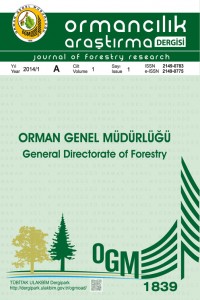Abstract
Orman yangınları, Akdeniz ikliminin egemen olduğu bölgelerde afet riski taşır. Sık ve büyük orman yangınları önemli sosyo-ekonomik ve ekolojik sonuçlara neden olur. Mersin ili sahip olduğu orman varlığı, artan nüfusu ve diğer coğrafi özellikleri (iklimi, topografyası, vd.) ile orman yangınlarına karşı son derece hassastır. Bu nedenle, her yıl çok sayıda orman yangını meydana gelir. Bu çalışma ile Mersin Orman Bölge Müdürlüğü kayıtlarındaki (2001-2013 yılları arası) 1038 orman yangınının başlangıç noktaları esas alınarak mekânsal dağılımları belirlenmiştir. Yangın sayısına göre, kategorik olarak sınıflandırılmış ve ağırlık değerleri hesaplanmış faktör haritaları elde edilmiş ve bu haritalar yardımıyla, potansiyel orman yangınları için yangına hassas yöreler sınıflanmıştır. Bu sınıflamaya göre, büyük yerleşim yerlerine yakın kızılçam ormanları, en hassas yöreler olarak ön plandadır. İlin orta bölümündeki maki yayılış alanı ile yüksek plato alanlarına geçiş kuşaklarındaki ormanlar ise hassasiyetin en az olduğu yörelerdir.
References
- BBaşaran, M. A., Sarıbaşak, H., Cengiz, Y., 2004. Yangın Söndürme Planı Temel Esaslarının Belirlenmesi (Manavgat Örneği), Batı Akdeniz Ormancılık Araştırma Müdürlüğü Teknik Bülten No:18, Antalya.
- Bilgili, E. and Goldammer, J.G. 2000. Fire in the Mediterranean Basin: Towards an interdisciplinary science programme. In proc. XXI IUFRO World Congress 2000, Forests and Society: The role of research, Vol.1, P.45-54.
- Bilgili, E. 2003. Stand development and fire behavior, Forest Ecology and Management Vol. 179, Issues 1–3, 3 July, p.333–339.
- Cáceres, C. F., 2011. Using GIS in Hotspots analysis and for forest fire risk zones mapping in the Yeguare Region, Southeastern Honduras. Papers in Resource Analysis, Volume 13, 14pp. Saint Mary’s University of Minnesota University Central Services Press. Winona, MN. http://www.gis.smumn.edu Retrieved (20.02.2014).
- Duran, C. 2012. Mersin ili orman alanlarının fizyografik özelliklere göre dağılımı. Uluslararası İnsan Bilimleri Dergisi (J-HumanSciences.com), 9 (1), 1-19.
- Duran, C. 2014. Relationship between rainfall distribution and physical geography elements within Mersin province, Turkey. Procedia-Social and Behavioral Sciences, 120 s.740-748.
- ESRI 2014. How Hot spot analysis: Getis-Ord Gi*
Abstract
Forest fires, in the regions in
which the Mediterranean climate is dominant, have risk of disasters. Frequent and extensive fires caused the
significant socio-economic and ecologic results. Mersin province with its
forests, dense population and other geographical
features (climate, topography, etc.) is extremely vulnerable to forest fires.
Therefore, every year many forest fires appear.
The purpose of this study was to determine the spatial analysis according to
start point of the 1038 recorded forest fires from 2001 to 2013 by the Mersin
Regional Directorate of Forestry. Factor maps classified as categorical and
calculated weights according to the number of fires were obtained. The
classification of sub-regions for the fire potential was made from the factor
maps. According to this classification, Calabrian pine forests close
to large residential areas are at the forefront as the most sensitive
sub-regions. Large maquis scrubland in the
middle of province and high
forest zones are sub-regions in the
least sensitive locations.
References
- BBaşaran, M. A., Sarıbaşak, H., Cengiz, Y., 2004. Yangın Söndürme Planı Temel Esaslarının Belirlenmesi (Manavgat Örneği), Batı Akdeniz Ormancılık Araştırma Müdürlüğü Teknik Bülten No:18, Antalya.
- Bilgili, E. and Goldammer, J.G. 2000. Fire in the Mediterranean Basin: Towards an interdisciplinary science programme. In proc. XXI IUFRO World Congress 2000, Forests and Society: The role of research, Vol.1, P.45-54.
- Bilgili, E. 2003. Stand development and fire behavior, Forest Ecology and Management Vol. 179, Issues 1–3, 3 July, p.333–339.
- Cáceres, C. F., 2011. Using GIS in Hotspots analysis and for forest fire risk zones mapping in the Yeguare Region, Southeastern Honduras. Papers in Resource Analysis, Volume 13, 14pp. Saint Mary’s University of Minnesota University Central Services Press. Winona, MN. http://www.gis.smumn.edu Retrieved (20.02.2014).
- Duran, C. 2012. Mersin ili orman alanlarının fizyografik özelliklere göre dağılımı. Uluslararası İnsan Bilimleri Dergisi (J-HumanSciences.com), 9 (1), 1-19.
- Duran, C. 2014. Relationship between rainfall distribution and physical geography elements within Mersin province, Turkey. Procedia-Social and Behavioral Sciences, 120 s.740-748.
- ESRI 2014. How Hot spot analysis: Getis-Ord Gi*
Details
| Journal Section | Conservation |
|---|---|
| Authors | |
| Publication Date | December 24, 2014 |
| Submission Date | August 1, 2014 |
| Published in Issue | Year 2014 Volume: 1 Issue: 1 A |
Cited By
AN ANALYSIS ON THE EXPENSES OF COMBATING FOREST FIRES: CASE OF KAHRAMANMARAŞ REGIONAL DIRECTORATE OF FORESTRY
TURKISH JOURNAL OF FOREST SCIENCE
Ömer EKER
https://doi.org/10.32328/turkjforsci.400491
Fire problem, distribution of fires and analysis of important fires in Mersin-Gülnar forests
Turkish Journal of Forestry | Türkiye Ormancılık Dergisi
Mustafa Avcı
https://doi.org/10.18182/tjf.292769
Remote sensing and GIS-based forest fire risk zone mapping: The case of Manisa, Turkey
Turkish Journal of Forestry | Türkiye Ormancılık Dergisi
Derya GÜLÇİN
https://doi.org/10.18182/tjf.649747
Türkiye’de orman yangını sorunu: Güncel bazı konular üzerine değerlendirmeler
Turkish Journal of Forestry | Türkiye Ormancılık Dergisi
Mustafa AVCI
https://doi.org/10.18182/tjf.942706
YANAN ORMAN ALANI TESPİTİNDE FARKLI UZAKTAN ALGILAMA İNDİSLERİNİN DEĞERLENDİRİLMESİ: 2022 YILI MERSİN (GÜLNAR) ORMAN YANGINI ÖRNEĞİ
ArtGRID - Journal of Architecture Engineering and Fine Arts
https://doi.org/10.57165/artgrid.1179074
Türkiye’deki 2000 – 2021 Yılları Arasındaki Bitki Örtüsü Yangınlarının Mekânsal Analizi
Turkish Journal of Remote Sensing and GIS
https://doi.org/10.48123/rsgis.1179051
Orman yol ağının orman yangınlarına etkisinin coğrafi bilgi sistemleri ile araştırılması
Anadolu Orman Araştırmaları Dergisi
https://doi.org/10.53516/ajfr.1456067

Turkish Journal of Forestry Research is licensed under a Creative Commons Attribution-NoDerivatives 4.0 International License.

